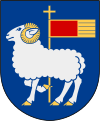Gotland Municipality
| Gotland Municipality Gotlands kommun | ||
|---|---|---|
| Municipality | ||
| ||
 | ||
| Coordinates: 57°38′N 18°17′E / 57.633°N 18.283°ECoordinates: 57°38′N 18°17′E / 57.633°N 18.283°E | ||
| Country | Sweden | |
| County | Gotland County | |
| Seat | Visby | |
| Area[1] | ||
| • Total | 15,241.07 km2 (5,884.61 sq mi) | |
| • Land | 3,134.05 km2 (1,210.06 sq mi) | |
| • Water | 12,107.02 km2 (4,674.55 sq mi) | |
| Area as of January 1, 2014. | ||
| Population (June 30, 2016)[2] | ||
| • Total | 57,498 | |
| • Density | 3.8/km2 (9.8/sq mi) | |
| Time zone | CET (UTC+1) | |
| • Summer (DST) | CEST (UTC+2) | |
| ISO 3166 code | SE | |
| Province | Gotland | |
| Municipal code | 0980 | |
| Website | www.gotland.se | |
Gotland Municipality (Swedish: Gotlands kommun) is a municipality that covers the entire island of Gotland in Sweden. The city of Visby is the municipality's seat.
History
On December 31, 1951 there were 93 local government units on the island of Gotland, among them one city (Visby), one market town (Slite), one county council and a lot of rural municipalities, many of them with less than 100 inhabitants.
Twenty years later the situation was totally different.
The first of the two nationwide local government reforms in Sweden during the 20th century was implemented on January 1, 1952. From that date on, the rural municipalities on the island were regrouped into twelve new enlarged municipalities, which together with Visby, Slite and the Gotland County Council formed the new administrative pattern.
After ten years it was clear that this reform had not been radical enough and the work began preparing for the next one.
On January 1, 1971 the second and last local government reform was implemented in Sweden. All administrative and judicial differences between rural and urban areas were abolished. Only one type of municipality (kommun) existed from that date on. In the case of Gotland all the former entities were united into one single unit. As there was only one municipality in the county, also the County Council was abolished and merged into the new unitary municipality.
Localities
There are 16 urban areas (also called a Tätort or locality) in Gotland Municipality.
In the table the localities are listed according to the size of the population. The municipal seat is in bold characters.
| # | Locality | Population in 2005 | Population in 2012[3] |
|---|---|---|---|
| 1 | Visby | 22,236 | 23,576 |
| 2 | Hemse | 1,836 | 1,734 |
| 3 | Slite | 1,598 | 1,500 |
| 4 | Klintehamn | 1,407 | 1,350 |
| 5 | Vibble | 1,135 | 1,300 |
| 6 | Romakloster | 905 | 949 |
| 7 | Fårösund | 862 | 800 |
| 8 | Lärbro | 521 | 500 |
| 9 | Burgsvik | 347 | 350 |
| 10 | Stånga | 342 | 300 |
| 11 | Havdhem | 318 | 300 |
| 12 | Västerhejde | 302 | n a[4] |
| 13 | Tingstäde | 278 | n a[4] |
| 14 | Väskinde | 275 | 250 |
| 15 | Roma kyrkby | 253 | n a[4] |
| 16 | När | 209 | n a[4] |
Politics
Election results:
| Party | Seats in the 2002 election | Seats in the 2006 election | Seats in the 2010 election | Seats in the 2014 election | |
|---|---|---|---|---|---|
| Swedish Social Democratic Party | 28 | 24 | 24 | 21 | |
| Centre Party | 13 | 17 | 15 | 14 | |
| Moderate Party | 11 | 14 | 15 | 13 | |
| Left Party | 8 | 7 | 6 | 7 | |
| Liberal People's Party | 4 | 4 | 4 | 4 | |
| Green Party | 4 | 4 | 7 | 8 | |
| Christian Democrats | 3 | 1 | 0 | 0 | |
| Sweden Democrats | 0 | 0 | 0 | 3 | |
| Feminist Initiative | 0 | 0 | 0 | 1 | |
| Total | 71 | 71 | 71 | 71 | |
Region
When Gotland was made into a single municipality in the 1970s, the county council was abolished and its responsibilities transferred to the municipality, making it a unitary authority. During a trial period some of the authority normally held by the Gotland County Administrative Board, an agency of the national government, has also been devolved to the Gotland Municipality, as well as to two mainland councils. The municipality of Gotland is there for in this respect also a region. It has responsibility for the public healthcare system and public transport.
Events organised by the municipality
The municipality coordinates the annual Almedalen Week (Almedalsveckan), an important meetingplace for everyone involved in Swedish politics. During the week, representatives from the political parties in the Riksdag take turns to hold speeches in the Almedalen park in Visby.
See also
References
- ↑ "Statistiska centralbyrån, Kommunarealer den 1 januari 2014" (Microsoft Excel) (in Swedish). Statistics Sweden. Retrieved 2014-04-18.
- ↑ "Folkmängd i riket, län och kommuner 30 juni 2016" (in Swedish). Statistics Sweden. August 17, 2016. Retrieved August 17, 2016.
- ↑ "Gotland i siffror, pdf". www.gotland.se. Region Gotland. pp. 65–67. Retrieved 13 June 2014.
- 1 2 3 4 Some numbers are not available for 2012, since the population was listed as inhabitants in each socken. Only a few localities were mentioned, and these only as approximations.
External links
- Gotland Municipality – Official site
- Coat of arms

